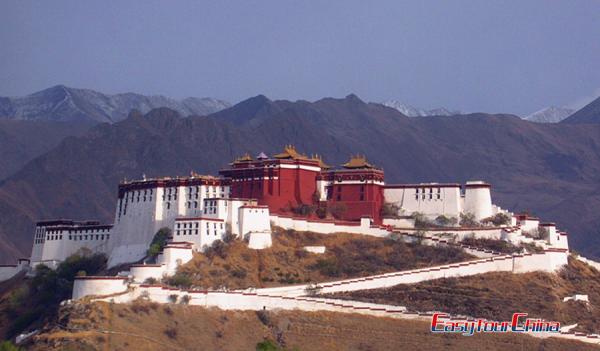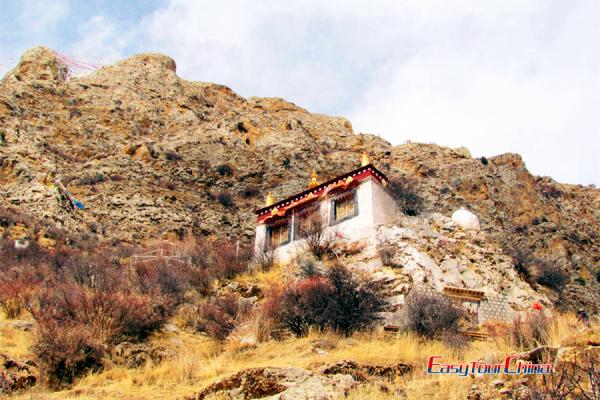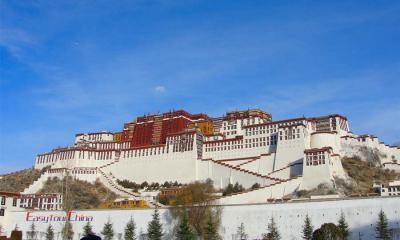Potala Palace
What is Potala Palace? The Potala, which in Tibetan means "High Heavenly Realm", is named after a stone cliff on Cape Comorin at the southern tip of India. It was sacred to the Buhhda of Compassion, whom the Indians worshipped as Avalokitesvara and the Tibetans believe to be Chenresik, who passed his spirit into the Dalai Lamas.
Built for several purposes, the Potala Palace served as administrative center, seat of government, monastery, fortress and the home of all the Dalai Lamas from the Fifth to the Fourteenth, although from the end of the eighteenth century, when the Norbulingka was built as the summer palace, they stayed here only in winter.
The Potala Palace covers an area of 360,000 square meters, with over 2,000 rooms and 34 Buddha halls. The general layout of the Potala includes the White Palace for the living quarters of the Dalai Lama and the Red Palace for religious functions. The Red Palace contains many halls and chapels - the most stunning chapels house the jewel-bedecked tombs of 5th to 13th Dalai Lamas. The apartments of the 13th and 14th Dalai Lamas in the White Palace offer an insight into the high life.
In the Potala Palace, there are a total of 57 butter lamp tenders. Unlike the monks in monasteries, they seldom get together to recite sutras and pray for blessings. They are put in charge of a certain number of Buddhas and the reception of pilgrims and visitors. In addition, they are charged with the mission of looking after cultural relics and working to prevent theft and fire damage.
The Potala Palace is a masterpiece of Tibetan architecture and a treasure house of Tibetan art -- it contains the golden handwritten Buddhist scriptures, valuable gifts from Chinese emperors, and a lot of priceless antiques. There are many colorful sculptures and paintings chronicling Buddhist folklore and ancient Tibetan life. The Potala Palace deserves the title of art gallery and museum; it is also a symbol of the wisdom and power of the Tibetan people. In 1994 it was listed as an UNESCO world cultural heritage site.
So can you visit Potala Palace? Yes! Now it is one of the must-see when you travel in Lhasa and one of the top tourist attractions in China.
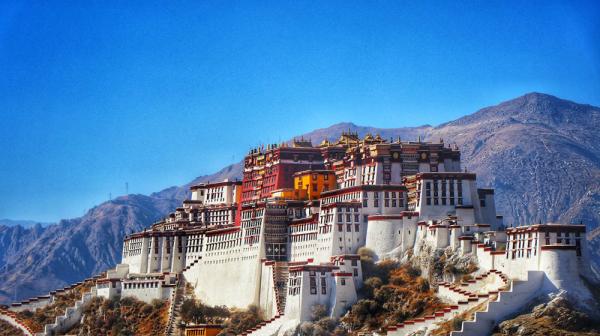
Potala Palace Facts
Brief History of Potala Palace in Tibet
When and why was Potala Palace built? Who built the Potala Palace? And how long did it take to build the Potala Palace?
In the 7th Century when the Tubo Empire were ruled under Songtsen Gampo:
After relocating the capital to Lhasa, Songtsen Gampo constructed a palace atop Red Hill to marry Princess Wencheng of the Tang Empire. This initial palace, known as Red Hill Palace, served as the precursor to the Potala Palace. The Red Mountain Palace was vast in scale, surrounded by three outer walls and housing a thousand chambers within. The entire palace complex was painted pure white, standing majestically on Red Mountain with an aura of sanctity and grandeur. Tibetans called it the “White Palace.” However, during the reign of Trisong Detsen, part of the palace was destroyed by lightning and fire. Later, when the Tibetan Empire collapsed, the palace was almost entirely destroyed, with only two chapels spared from the ravages of war.
From 9th Century AD to Mid-17th Century:
After the collapse of the Tubo Empire, Tibet remained in a state of political fragmentation for a long time, and the Red Mountain Palace gradually fell into disrepair. Since the successive Sakya, Phagmodrupa, and Karma dynasties never established their capitals in Lhasa, the Red Mountain Palace was never rebuilt, becoming an important religious venue. Representative figures from various sects, including the Kadampa monk Qiongbu Zhase, the Kagyu Tsultrim Karmapa Desin Sheppa, and Tsongkhapa, the founder of the Gelug school, held lectures and other Buddhist ceremonies here.
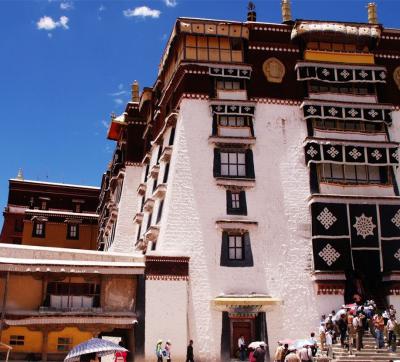
From Mid-17th Century to 20th Century:
In the mid-17th century, Gushri Khan, leader of the Mongol Khoshut tribe, led his forces into Tibet and overthrew the Karma Dhondup Wangpo regime. In 1642, the Fifth Dalai Lama established the Ganden Phodrang, a theocratic government, restoring Lhasa as Tibet's political, religious, economic, and cultural center.
1645–1648: To consolidate the secular-religious Ganden Phodrang administration, the Fifth Dalai Lama rebuilt the Potala Palace's “White Palace,” its walls, gates, and corner towers, relocating the government apparatus from Drepung Monastery. The complex centered on the White Palace was largely completed three years later, with the Fifth Dalai Lama taking residence in 1653. From then on, successive Dalai Lamas resided here, and major religious and political ceremonies were held here, establishing the Potala Palace as the center of Tibet's theocratic rule.
1690-1694: Sangye Gyatso built a stupa for the Fifth Dalai Lama and expanded the Red Palace, completing the project in 1693. Successive Dalai Lamas subsequently added to and renovated the Potala Palace. For example, during the reign of the 13th Dalai Lama, the East Sunlight Hall and several ancillary buildings at the foot of the Potala Palace were added to the east side of the White Palace. Following the 13th Dalai Lama's death in 1933, construction began on the 13th Dalai Lama's stupa between 1934 and 1936, integrating the Red Palace with the 13th Dalai Lama's stupa. By this point, the Potala Palace's architectural scale had been largely finalized.
Modern Conservation:
Since the 1980s, China has invested billions of yuan in two major restoration projects for the Potala Palace. Engineering and technical personnel have undertaken numerous research initiatives to advance cultural heritage conservation techniques.
The Potala Palace Architecture
The Potala Palace is a magnificent structure that combines palaces, castles and temples. It houses and preserves a wealth of historical relics and art treasures. It stands as the largest and most complete ancient palace-fortress complex still extant in the Tibetan region, embodying the traditional Tibetan architectural style of earth, stone, and wood construction with watchtower elements. Historical records indicate that during the construction of the Red Palace, Emperor Kangxi of Qing Dynasty specifically dispatched over a hundred artisans from Han, Manchu, Mongol, and other ethnic groups to Tibet to participate in the expansion of the Potala Palace. Thus, the Potala also absorbed and drew upon the essence of ancient Chinese architecture.
Layout, Interiors, and Functions
The Potala Palace is designed and constructed according to the layout of a Buddhist mandala. It consists of two main parts: the Red Palace and the White Palace. The Red Palace is located in the center, with an external appearance of 13 floors, but the actual height within the palace is 9 floors. The White Palace spans both wings and is 7 floors high. The top floor of the White Palace of the Potala Palace is the Dalai Lama's palace. It includes not only the Dalai Lama's living quarters, study rooms, and assembly halls, but also places for deliberation and receiving guests. Inside the Potala Palace, there are 38 various Buddhist temples, including the Dalai Lama's shrine hall. And there is also a highly auspicious monastery with 175 monks, mainly engaged in the religious activities of the Dalai Lama.
White Palace
The White Palace of Potala Palace served as the Dalai Lama's winter residence and once housed the administrative offices of the former Tibetan regional government.
In the 9th century, the Potala Palace was damaged during internal turmoil in the Tibetan Empire, with only the White Palace's Dharma King Cave surviving—the oldest extant structure within the complex.
The uppermost level of the White Palace houses the Dalai Lamas' private quarters, known as the Sunlight Halls. The Western Sunlight Hall and Eastern Sunlight Hall served as the private chambers for the 13th and 14th Dalai Lamas respectively, where they also conducted state affairs. These halls are exceptionally lavish.
The sixth and fifth levels of the White Palace are dedicated to living quarters and offices.
The fourth floor houses the White Palace's largest hall, the Great East Hall (Tsechen Lhakhang). Measuring 27.8 meters long and 25.8 meters wide, it contains the Dalai Lama's throne, making it the throne room of Potala Palace. Major events at Potala Palace, such as the Dalai Lama's enthronement ceremony and the ceremony marking his assumption of full authority, are held here.
Outside the White Palace, a zigzagging stairway ascends the mountain. On the eastern hillside lies a broad plaza known as the Tsangyul Tsang, where the Dalai Lama watched theatrical performances and held outdoor events. Monastic administrative schools and other institutions were built along the plaza's north and south sides.
The White Palace connects to the Tsangyul Tsang below the Red Palace, serving as the residence for the lamas who maintained the Potala Palace. At its peak, it housed over 25,000 monks.
>> Recommended Tibet Tours with Potala Palace:
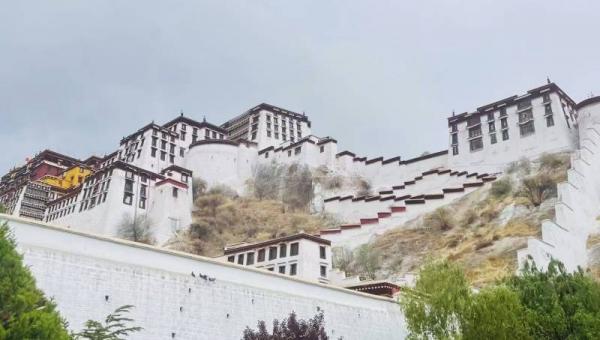
Red Palace
The Red Palace of Potala Palace adopts a mandala layout, with numerous prayer halls and shrines built around the stupa chapels of successive Dalai Lamas, thus forming an integrated complex with the White Palace.
The most significant structures within the Red Palace are the stupa chapels of the successive Dalai Lamas, totaling five: those of the 5th, 7th, 8th, 9th, and 13th Dalai Lamas. The Western Hall (Tsokchen Lhu) of the Fifth Dalai Lama's stupa shrine is the largest chamber in the Potala Palace, standing over 6 meters tall with an area of 725.7 square meters. The hall features 698 murals, most depicting scenes from the Fifth Dalai Lama's life. To the west of the Red Palace lies the stupa shrine of the Thirteenth Dalai Lama, constructed in 1936 as the palace's latest addition.
The Hall of the Three Realms (Sasong Langjie) is the highest hall within the Red Palace. Inside stands an altar tablet inscribed in Tibetan, Han, Manchu, and Mongolian script with the words “Long Live the Emperor.” Above the tablet hangs a portrait of Emperor Qianlong of the Qing Dynasty. Surrounding the altar are statues of Vajradhara, Tsongkhapa, and others.
The Palace of the Dharma King within the Red Palace is said to have been Songtsen Gampo's meditation retreat. It now enshrines statues of Songtsen Gampo, Princess Chizun, Princess Wencheng, and their ministers. The Hall of the Holy One enshrines the principal Buddha of Songtsen Gampo—a naturally formed sandalwood statue of Avalokitesvara Bodhisattva.
>> Recommended 5 Days Tibet Adventure Tour for Family
Art and Cultural Treasures in Potala Palace: Understand why It is important
The palace houses over 2,500 square meters of murals, nearly a thousand pagodas, tens of thousands of statues, and tens of thousands of thangka scrolls, and 8 gold-topped stupas and 5 three-dimensional mandalas. There are also over 60,000 volumes (pieces) of precious scriptures, including the Bayeux and Kangyur. Also included are golden books, gold seals, and jade seals bestowed upon the successive Dalai Lamas by emperors of the Ming and Qing dynasties. Moverover, when visitng Potala Palace, you will discover a large collection of gold and silver items, porcelain, enamelware, jade, brocade, and other rare artifacts.
Best Time to Visit the Potala Palace
Lhasa, where the Potala Palace is located, lies on the Tibetan Plateau. For first-time travelers to Tibet, we recommend visiting the Potala Palace between May and October, when the warm, humid climate and high oxygen levels help alleviate altitude sickness.
If the altitude doesn't bother you and you're not afraid of the cold and dry weather of Lhasa in winter, you can also visit between November and February, when crowds are fewer and ticket prices are more affordable.
The Potala Palace at night offers a completely different charm than during the day, allowing you to photograph the illuminated nightscape.
>> Recommended China Tour Packages including Tibet Potala Palace:
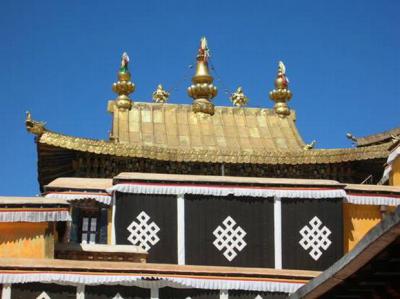
How to Get to Potala Palace
Bus stops near the Potala Palace:
Xishan Scenic Area, Xishan Mountain, Yujueyuan, Osmanthus Intersection, Silk Road, Xingjing Bridge, Red Flag Plaza, Silk Intersection, Section of Yudai Middle Road, Huifeng Road, Yudai North Road, Xihua Bridge, Silk Road, Qile Bridge, Lijing Garden, Yudai Intersection.
Lhasa city buses that can reach the Potala Palace:
Bus No.22, No.25, No.26, No.2, No.6, Tourist Route 1, Tourist Route 3, Route 11, Route 7, Route 23 (round trip), Route 37, etc.
How much does it cost to take a taxi to the Potala Palace?
For your reference, the starting fare for taxis in Lhasa is 10 yuan, with a starting distance of 3 kilometers and a rate of 2 yuan per kilometer. There is no fuel surcharge.
Plan Your Lhasa Potala Palace Tour with Us
Delve into the ancient history of Tibet as you a spiritual journey to Lhasa and the Potala Palace, Jokhang Monastery, Sera Monastery, etc where timeless Tibetan Buddhist traditions come with heart-stealing views. At Easy Tour China, our Tibet travel experts can tailor make a tour of Potala Palace that reveal this landmark inside out.
